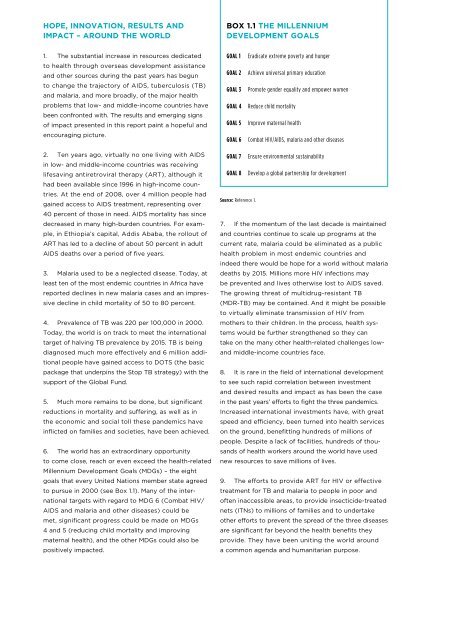Global Fund: Progress Report 2010 - unaids
Global Fund: Progress Report 2010 - unaids
Global Fund: Progress Report 2010 - unaids
You also want an ePaper? Increase the reach of your titles
YUMPU automatically turns print PDFs into web optimized ePapers that Google loves.
Hope, innovation, results and<br />
impact – around the world<br />
BOX 1.1 The mILLENNIUm<br />
dEVELOPmENT GOALS<br />
1. The substantial increase in resources dedicated<br />
to health through overseas development assistance<br />
and other sources during the past years has begun<br />
to change the trajectory of AIDS, tuberculosis (TB)<br />
and malaria, and more broadly, of the major health<br />
problems that low- and middle-income countries have<br />
been confronted with. The results and emerging signs<br />
of impact presented in this report paint a hopeful and<br />
encouraging picture.<br />
GOAL 1<br />
GOAL 2<br />
GOAL 3<br />
GOAL 4<br />
GOAL 5<br />
GOAL 6<br />
Eradicate extreme poverty and hunger<br />
Achieve universal primary education<br />
Promote gender equality and empower women<br />
Reduce child mortality<br />
Improve maternal health<br />
Combat HIV/AIDS, malaria and other diseases<br />
2. Ten years ago, virtually no one living with AIDS<br />
in low- and middle-income countries was receiving<br />
lifesaving antiretroviral therapy (ART), although it<br />
had been available since 1996 in high-income countries.<br />
At the end of 2008, over 4 million people had<br />
gained access to AIDS treatment, representing over<br />
40 percent of those in need. AIDS mortality has since<br />
decreased in many high-burden countries. For example,<br />
in Ethiopia’s capital, Addis Ababa, the rollout of<br />
ART has led to a decline of about 50 percent in adult<br />
AIDS deaths over a period of five years.<br />
3. Malaria used to be a neglected disease. Today, at<br />
least ten of the most endemic countries in Africa have<br />
reported declines in new malaria cases and an impressive<br />
decline in child mortality of 50 to 80 percent.<br />
4. Prevalence of TB was 220 per 100,000 in 2000.<br />
Today, the world is on track to meet the international<br />
target of halving TB prevalence by 2015. TB is being<br />
diagnosed much more effectively and 6 million additional<br />
people have gained access to DOTS (the basic<br />
package that underpins the Stop TB strategy) with the<br />
support of the <strong>Global</strong> <strong>Fund</strong>.<br />
5. Much more remains to be done, but significant<br />
reductions in mortality and suffering, as well as in<br />
the economic and social toll these pandemics have<br />
inflicted on families and societies, have been achieved.<br />
6. The world has an extraordinary opportunity<br />
to come close, reach or even exceed the health- related<br />
Millennium Development Goals (MDGs) – the eight<br />
goals that every United Nations member state agreed<br />
to pursue in 2000 (see Box 1.1). Many of the international<br />
targets with regard to MDG 6 (Combat HIV/<br />
AIDS and malaria and other diseases) could be<br />
met, significant progress could be made on MDGs<br />
4 and 5 (reducing child mortality and improving<br />
maternal health), and the other MDGs could also be<br />
positively impacted.<br />
GOAL 7 Ensure environmental sustainability<br />
GOAL 8 Develop a global partnership for development<br />
Source: Reference 1.<br />
7. If the momentum of the last decade is maintained<br />
and countries continue to scale up programs at the<br />
current rate, malaria could be eliminated as a public<br />
health problem in most endemic countries and<br />
indeed there would be hope for a world without malaria<br />
deaths by 2015. Millions more HIV infections may<br />
be prevented and lives otherwise lost to AIDS saved.<br />
The growing threat of multidrug-resistant TB<br />
(MDR-TB) may be contained. And it might be possible<br />
to virtually eliminate transmission of HIV from<br />
mothers to their children. In the process, health systems<br />
would be further strengthened so they can<br />
take on the many other health-related challenges lowand<br />
middle-income countries face.<br />
8. It is rare in the field of international development<br />
to see such rapid correlation between investment<br />
and desired results and impact as has been the case<br />
in the past years’ efforts to fight the three pandemics.<br />
Increased international investments have, with great<br />
speed and efficiency, been turned into health services<br />
on the ground, benefitting hundreds of millions of<br />
people. Despite a lack of facilities, hundreds of thousands<br />
of health workers around the world have used<br />
new resources to save millions of lives.<br />
9. The efforts to provide ART for HIV or effective<br />
treatment for TB and malaria to people in poor and<br />
often inaccessible areas, to provide insecticide-treated<br />
nets (ITNs) to millions of families and to undertake<br />
other efforts to prevent the spread of the three diseases<br />
are significant far beyond the health benefits they<br />
provide. They have been uniting the world around<br />
a common agenda and humanitarian purpose.

















